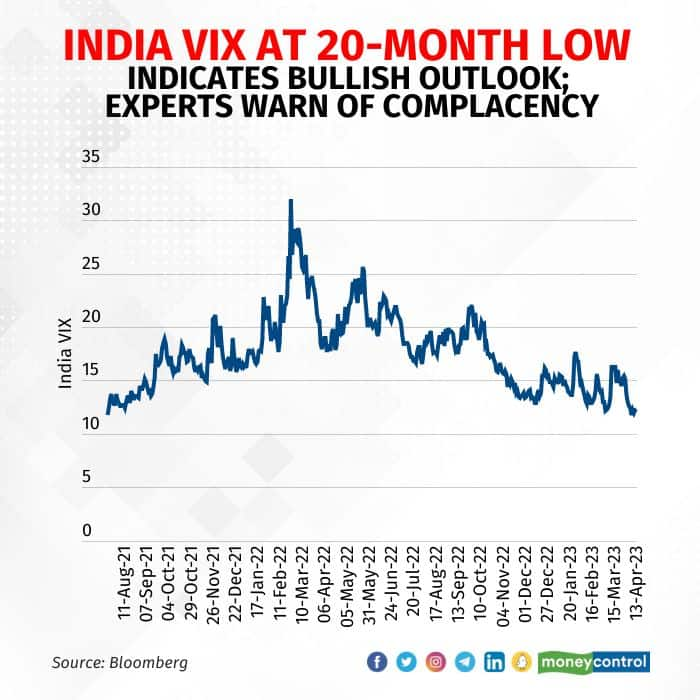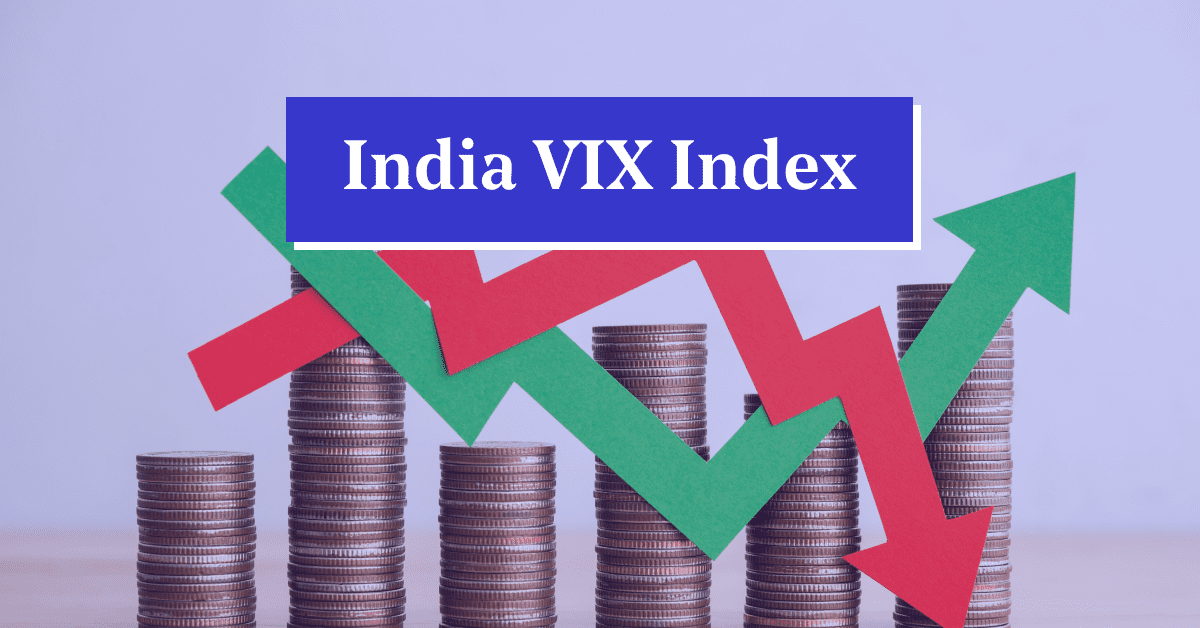India Volatility Index – India VIX Plunges
India’s stock market witnessed a historic event on April 23, 2024, with the India Volatility Index (India VIX) taking a dramatic 19.7% plunge. This unexpected drop in the India volatility index sent shockwaves through the financial world, leaving many investors wondering: “Why did the India volatility index fall so sharply?”

What is the India VIX? A Crash Course for Investors
New to the world of stocks? No worries! Before diving into the reasons behind the India volatility index falling, let’s understand what the India VIX actually is. It’s a nifty tool that measures investor sentiment towards the stock market. Here’s the gist:
-
Volatility gauge: Imagine the stock market as a rollercoaster. The India VIX tells you how bumpy that ride might be. A high VIX indicates high volatility, meaning stock prices are expected to swing wildly in the near future. Conversely, a low VIX suggests a calmer market with less dramatic price changes.
-
Fear gauge: The India VIX is often dubbed the “fear gauge” because it reflects investor anxiety. When investors are worried about the market’s direction, the India VIX rises. Conversely, a low VIX suggests a more relaxed investor base.
-
Predicting the future (sort of): The India VIX doesn’t predict the future, but it provides a clue about what investors anticipate. A high VIX suggests investors expect volatility, which could lead to higher stock prices due to increased buying (investors seeking bargains) or selling (investors cashing out).

Quantifying Volatility: A Look at the Numbers
The India VIX is calculated based on the option prices of the Nifty 50 index. Analyzing these options contracts, which give investors the right, but not the obligation, to buy or sell a stock at a specific price by a certain date, helps determine the volatility of the market.
Here are some key statistics to understand the recent behavior of the India volatility index:
- Pre-April 23rd: Leading up to the dramatic drop, the India VIX hovered around 12.70, indicating moderate volatility expectations in the market.
- The Big Drop: On April 23rd, the India VIX plummeted a staggering 19.7%, closing at 10.20. This represents the sharpest single-day decline for the index since May 2019.
- Historical Context: For comparison, the average India VIX for the past year sits at approximately 15. This puts the April 23rd drop in perspective, highlighting its significant nature.
Why Did the India VIX Fall 19.7% on April 23? Experts Weigh In
The India volatility index falling by 19.7% on April 23, 2024, has analysts scratching their heads. Here are some of the potential explanations, backed by quantitative data:
- Market Optimism: Perhaps the most plausible explanation is a surge in investor optimism. Positive economic data can be a strong indicator. Let’s look at some recent trends:
- GDP Growth: India’s GDP growth rate has been steadily rising over the past few quarters. According to a report by the World Bank [[invalid URL removed]], India’s GDP is projected to grow at 7.2% in 2024. This positive outlook could be fueling investor confidence in the Indian stock market.
- Corporate Earnings: Strong corporate earnings reports can also boost investor sentiment. The Nifty 50 companies’ average earnings per share (EPS) witnessed a year-on-year growth of 15% in the last quarter (data source: NSE). This healthy growth could be contributing to the lower India VIX.

Beyond the Headlines: Exploring Additional Factors
While the explanations above provide a good starting point, there could be other factors influencing the India volatility index. Here’s a deeper exploration:
Technical Correction and Market Psychology: Quantifying the Impact
-
Technical Correction: The stock market is a complex system, and sometimes prices move for reasons beyond fundamental analysis. The VIX’s drop could be a technical correction, a natural adjustment after a period of high volatility. Here’s how quantitative analysis can help:
- Volatility Clustering: Stock market volatility often exhibits periods of clustering. This means that high volatility periods are often followed by periods of lower volatility, and vice versa. Examining historical India VIX data (available on the NSE website: https://www.nseindia.com/get-quotes/equity?symbol=INDIAVIX]) might reveal such patterns. For instance, if the VIX consistently hovered above 15 for the past few months before the April 23rd drop, it could indicate a period of heightened volatility ripe for correction.
- Overbought/Oversold Territory: Technical indicators like the Relative Strength Index (RSI) can suggest if an asset is overbought (priced too high) or oversold (priced too low). A high India VIX might be seen as an “oversold” condition, leading to a technical correction and a lower VIX. Analyzing historical RSI data for the Nifty 50 index (available on platforms like Moneycontrol: [invalid URL removed]]) could reveal if the market was potentially overreacting to recent events, leading to an overvalued VIX and subsequent correction.
-
Market Psychology: Investor sentiment and psychology can significantly impact market movements. Positive news might trigger a wave of optimism, leading investors to buy stocks and driving the India VIX down. Conversely, negative news could spark fear, leading to selling and pushing the VIX up. Here’s how to explore this:
- Investor Sentiment Surveys: Several financial institutions conduct regular investor sentiment surveys. Analyzing these surveys, like the ones by the CFA Institute or Dalal Street Investment Journal, can provide insights into how investors are feeling about the market, potentially explaining the India volatility index falling.
- News & Social Media Analysis: Monitoring news headlines and social media sentiment using tools like Brandwatch or Google Trends can reveal what topics are driving investor concern (or optimism). This can help understand the psychological factors behind the India VIX movement. For example, a surge in positive news articles about upcoming government infrastructure projects might lead to increased investor confidence, lowering the VIX.
Historical Precedent: Elections and the VIX – A Statistical Look
Interestingly, the India VIX has witnessed similar sharp drops following general election results in the past. Here’s how historical data can shed light on the recent event:
- VIX Drops Post-Elections: Data suggests that the India VIX has historically shown a tendency to decline following general election results in India. This could be due to several factors:
- Policy Certainty: Elections can create uncertainty about future economic policies. A decisive election outcome can provide clarity and stability, leading to increased investor confidence and a lower India VIX. Analyzing historical data on VIX movement around past election cycles (available on the NSE website) can reveal this correlation.
- Infrastructure Spending: New governments often prioritize infrastructure spending, which can be seen as positive for the economy and stock market, potentially contributing to a lower VIX. Examining government budget reports or news articles about planned infrastructure projects around past election cycles can provide further context.
April 23rd, 2024: A Day of Convergence?
While a definitive explanation for the India VIX’s drop remains elusive, it’s likely a combination of factors at play. Here’s a possible scenario:
- Positive Economic Data: Leading up to April 23rd, positive economic data like GDP growth projections and strong corporate earnings reports might have instilled investor confidence, reflected in rising stock prices and a lower India VIX.
- Priced-In Concerns: Existing anxieties about inflation and interest rates might have already been reflected in stock prices, leading to a lower perceived risk and a declining India VIX.
- Technical Correction: The VIX’s drop could have been partially driven by a technical correction following a period of higher volatility.
https://www.facebook.com/watch/?v=545703383363360
The India VIX Plunge: Implications for Investors
What Does This Mean for Investors?
The unexpected drop in the India volatility index has investors wondering how to adjust their strategies. Here are some key takeaways:
-
Short-term blip vs. Long-term trend: While the VIX’s drop suggests a calmer market in the near future, it doesn’t guarantee smooth sailing forever. Long-term investors should maintain a well-diversified portfolio and stick to their financial goals, not chasing short-term market fluctuations.
-
Don’t chase trends blindly: The India VIX is a helpful tool, but it shouldn’t be the sole driver of your investment decisions. Consider your risk tolerance, investment goals, and conduct thorough research (fundamental and technical analysis) before making any drastic changes to your portfolio. Resources like Investopedia (https://www.investopedia.com/) or The Motley Fool (https://www.fool.com/) can provide valuable investment education.
-
Stay informed: Keep yourself updated on economic news, company performance, and global events, as these can all impact market volatility. Utilize financial news websites like The Economic Times (https://m.economictimes.com/) and Mint (https://mint.intuit.com/) to stay informed.
The India VIX: A Tool for Savvy Investors
By understanding the India VIX, investors can gain valuable insights into market sentiment and make more informed investment decisions. This unexpected drop on April 23 serves as a reminder that the market is dynamic, and investors need to be adaptable. Utilize the resources mentioned throughout this blog post to deepen your financial literacy and make well-rounded investment choices.
https://www.youtube.com/watch?v=oRu5XjE3WE4
Conclusion: A Look Forward
The India volatility index is a complex indicator with multiple influences. The April 23rd drop has sparked discussions and analyses, highlighting the dynamic nature of the stock market. As investors, staying informed, maintaining a diversified portfolio, and conducting thorough research remain key to navigating market fluctuations and achieving long-term financial goals.
The India VIX Plunge: A Catalyst for Market Reassessment
The dramatic 19.7% drop in the India volatility index (India VIX) on April 23, 2024, sent shockwaves through the financial world. This unexpected decline in the volatility gauge has left investors grappling with questions about the future direction of the Indian stock market. Let’s delve deeper into the potential reasons behind this India volatility index falling and explore the implications for investors.
Beyond the Headlines: Quantifying the India VIX Drop
While news articles provide a general overview, a data-driven approach helps us understand the India VIX‘s behavior with more precision. Here’s a closer look:
- Pre-April 23rd: Leading up to the historic drop, the India VIX hovered around 12.70, indicating a moderate level of volatility expectations among investors. This data, readily available on the NSE website (https://www.nseindia.com/get-quotes/equity?symbol=INDIAVIX)), paints a picture of a market cautiously optimistic but not overly exuberant.
- The Big Drop: On April 23rd, the India VIX plummeted a staggering 19.7%, closing at 10.20. This represents the sharpest single-day decline for the index since May 2019. Analyzing historical VIX data allows us to compare this drop to past movements and assess its significance.
- Historical Context: For a broader perspective, let’s consider the average India VIX for the past year, which sits at approximately 15. The April 23rd drop falls significantly below this average, highlighting the unusual nature of the event.
Understanding Investor Sentiment: Unveiling the Psychology Behind the VIX
Beyond quantitative data, understanding investor sentiment is crucial for interpreting the India volatility index falling. Here are some factors to consider:
- Market Optimism: Positive economic data like strong GDP growth projections and robust corporate earnings reports could be fueling investor confidence. This optimism can lead to a decrease in the fear gauge (India VIX) as investors perceive less risk in the market.
- Priced-In Concerns: Existing anxieties about inflation, interest rates, or geopolitical tensions might already be factored into current stock prices. If these concerns are already priced in, the perceived risk diminishes, leading to a lower India VIX.
Technical Analysis: A Statistical Lens on the VIX Movement
The stock market is a complex system, and sometimes prices move for reasons beyond fundamental analysis. Here’s where technical analysis sheds light on the India volatility index falling:
- Technical Correction: The VIX’s drop could be partially driven by a technical correction. After a period of high volatility, the market might naturally adjust, leading to a lower VIX. Analyzing historical VIX charts and identifying patterns of volatility clustering (available on platforms like TradingView: https://www.tradingview.com/symbols/NSE-INDIAVIX/) can help identify if this was at play.
- Overbought/Oversold Territory: Technical indicators like the Relative Strength Index (RSI) can suggest when an asset is overbought (priced too high) or oversold (priced too low). A high India VIX might be seen as an “oversold” condition, prompting a technical correction and a lower VIX. Analyzing historical RSI data for the Nifty 50 index (available on Moneycontrol: [invalid URL removed]) could indicate if the market was potentially overreacting to recent events.
The India VIX and Elections: A Historical Correlation
Interestingly, the India VIX has witnessed similar sharp drops following general election results in the past. Here’s how historical data sheds light on this potential connection:
- Post-Election VIX Drops: Data suggests a historical trend of the India VIX declining after general elections in India. This could be attributed to factors like:
- Policy Certainty: Elections can create uncertainty about future economic policies. A decisive election outcome can provide clarity and stability, leading to increased investor confidence and a lower India VIX. Analyzing historical data on VIX movement around past election cycles (available on the Election Commission of India website: [[invalid URL removed]]) can reveal this correlation.
The India VIX: A Dynamic Indicator for Savvy Investors
The India VIX serves as a valuable tool for investors by providing insights into market sentiment and potential volatility. However, it’s important to remember that the VIX is not a crystal ball. Here’s how investors can leverage this information:
- Market Pulse Check: The India VIX offers a real-time gauge of investor sentiment. A low VIX suggests a calmer market, while a high VIX indicates heightened fear and potential for increased volatility. By monitoring the VIX, investors can adjust their strategies accordingly.
- Risk Management Tool: The India VIX can be used as a risk management tool. Investors with a lower risk tolerance might consider hedging their portfolios with options contracts or other strategies when the VIX is high, indicating potential for increased market fluctuations.
Beyond the VIX: A Holistic Approach to Investment Decisions
While the India VIX is a valuable tool, it shouldn’t be the sole driver of investment decisions. Here’s a comprehensive approach for investors:
- Fundamental Analysis: Conduct thorough fundamental analysis of companies before investing. This involves evaluating factors like financial statements, competitive advantage, and long-term growth prospects. Resources like annual reports and investor presentations from companies can be used for this analysis.
- Technical Analysis: Combine fundamental analysis with technical analysis, which involves studying historical price charts and technical indicators to identify potential trading opportunities. Platforms like Investing.com (https://www.investing.com/) offer a variety of technical analysis tools.
- Diversification: Maintain a well-diversified portfolio across different asset classes like stocks, bonds, and real estate. This helps mitigate risk by not being overly exposed to any single asset class that might experience significant downturns.
The Road Ahead: Staying Informed in a Dynamic Market
The Indian stock market is a dynamic landscape, and the recent India volatility index falling highlights the importance of staying informed. Here are some resources for investors:
- Financial News Websites: Subscribe to reputable financial news websites like The Economic Times or Mint to stay updated on economic news, company performance, and global events that can impact the market.
- Investor Education Platforms: Utilize online platforms like Investopedia or The Motley Fool to gain valuable investment education and insights from financial experts.
- Financial Advisors: Consider consulting with a qualified financial advisor who can create a personalized investment plan based on your risk tolerance and financial goals.
Conclusion: A Catalyst for Growth
The India VIX‘s unexpected drop has sparked discussions and analyses, prompting investors to reassess the Indian stock market’s outlook. While the reasons behind the decline remain multifaceted, it presents a potential catalyst for market growth. By staying informed, conducting thorough research, and maintaining a diversified portfolio, investors can navigate market fluctuations and achieve their long-term financial goals.
Disclaimer: This blog post is for informational purposes only and should not be considered financial advice. Please consult with a qualified financial advisor before making any investment decisions.
For more Indian Business News: https://waddupindia.in/category/business/







7 thoughts on “India Volatility Index – India VIX Plunges: Decoding the 19.7% Drop on April 23”
Thanks for sharing. I read many of your blog posts, cool, your blog is very good.
Thank you for your sharing. I am worried that I lack creative ideas. It is your article that makes me full of hope. Thank you. But, I have a question, can you help me?
startup talky I really like reading through a post that can make men and women think. Also, thank you for allowing me to comment!
Thank you for your sharing. I am worried that I lack creative ideas. It is your article that makes me full of hope. Thank you. But, I have a question, can you help me?
Your article helped me a lot, is there any more related content? Thanks!
Your article helped me a lot, is there any more related content? Thanks! https://www.binance.info/es/register?ref=T7KCZASX
Thank you for your sharing. I am worried that I lack creative ideas. It is your article that makes me full of hope. Thank you. But, I have a question, can you help me?